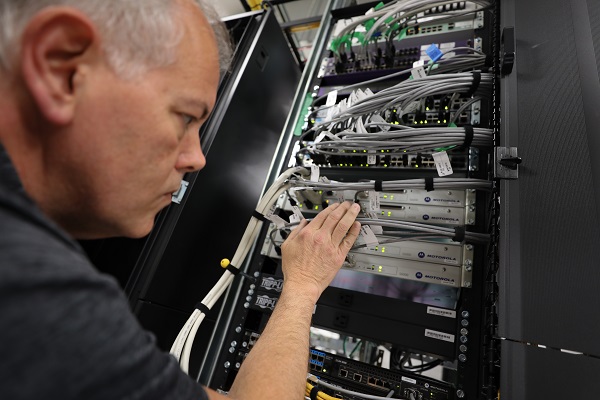As October Cybersecurity Awareness Month comes to an end, today’s blog will focus on some best practices you can apply now and every day to protect your systems and technologies. Effective cybersecurity can be the difference in creating a safe, protected and connected community, while keeping mission-critical systems up-and-running at maximum performance levels.
Whether it’s a radio, dispatch console or infrastructure component, designing a secure technology architecture from the ground up and implementing robust security controls is paramount to ensure that your mission-critical voice and data is safeguarded. Here are some best practices that can be implemented to protect systems and data.
1. Infrastructure and device security
Whether it is your Land-Mobile Radio (LMR) and Public Safety Answering Point (PSAP) network or your radios and LTE devices, it is important to implement strong data and voice encryption to ensure unauthorized and unwarranted users do not have access to your communication systems and the information they carry. Securing at the highest level of encryption (for example: AES 256, hardware-based encryption) and following a regular rotation of encryption keys can help protect sensitive data and enhance security of communication.
You should also be performing regular software and firmware updates that are certified and tested for continuous security, performance and enhanced functionality of your infrastructure and devices. Investing in planned updates for your network and device equipment — switches, routers, Wi-Fi access points, Bluetooth and other device accessories — helps expand your capabilities beyond voice communications to increase security and resilience.
Internet-connected systems provide an easy avenue for cyber attacks. All system elements that have internet connectivity need to be deployed behind a firewall and anti-malware protection should be applied on all servers and endpoints. You should also have strong authentication processes in place to validate users and machines, where possible.
Man-in-the-middle attacks, Distributed Denial of Service (DDoS) attacks and session hijacking are some of the most common Wi-Fi attacks. In addition to having strong password control policies you should segregate your radio Wi-Fi network from your enterprise Wi-Fi network for greater compartmentalization and implement Wi-Fi authentication (minimally WPA2 recommended).
2. Best practices for user management
When it comes to creating and managing employee cybersecurity policies, there are numerous ways to protect your organization and engage your workforce.
Creating strong password policies is a key area. Most employees prefer easy-to-remember passwords, and many reuse the same password for all their accounts – including access to your organization’s data and systems. This can leave your systems vulnerable to attacks. A little cybersecurity training will go a long way, so teach your team to create a unique password phrase that they’ll remember, and establish technical controls for enforcing strong passwords. As part of this, set up controls for strong passwords and ensure they are changed when you suspect that the system or password may have been compromised.
Managing and auditing privileged accounts is another critical area for creating a strong cybersecurity program. Make it part of your monitoring and reporting to look at who has admin privileges on devices, systems and applications and shut down access to anyone who shouldn’t have permissions on these accounts. Attackers typically leverage elevated privileges to gain permission to install their malware and open sensitive files, and NIST provides guidance for reducing the risk of these powerful accounts. Establish a regular review cycle to ensure that this is part of your ongoing cybersecurity program, and not just an occasional exercise. Set up technical controls wherever possible to enforce this.
3. Creating a successful cybersecurity training and awareness program
Unfortunately, even with cyber threats being front and center in the news these days, many employees still believe that cybersecurity is something for the IT team to worry about. While this is true to a degree, the adage “it takes a village” is a much more appropriate stance. Employees can form a human line of defense that supports a host of security activities. This can include reporting suspicious emails and phishing attempts, learning how to identify and avoid social engineering attacks and developing a cyber-aware mindset.
One of the most effective ways to do this is to educate employees as part of the onboarding process and require regular annual training that is mapped to employee responsibilities, system access and your organization’s tolerance for risk.
4. Operationalize your security program
Understanding your weaknesses through regular cybersecurity assessments and audits is critical. Without them, it’s difficult to withstand cyber attacks and protect your organization. Knowing your weaknesses helps you focus on what you need to do to improve your cyber security posture. In addition, performing periodic pentests and regularly patching systems are powerful tools to strengthen cyber resilience.
With advanced threat actors always on the lookout, implementing a proactive security monitoring and incident response plan is a must. Regardless of how big or small your organization is, cutting-edge automation and orchestration tools coupled with deep expertise can help protect your network, cloud applications and infrastructure, devices and endpoints.
Beyond Cybersecurity Awareness Month, Motorola Solutions is committed to providing secure products and solutions, and delivering cybersecurity services for organizations across the globe. Cybersecurity is not about snapshot thinking nor just relevant during the month of October. To support our customers, Motorola Solutions will continue to share how you can better protect your mission and investments through the year and going into 2021.




